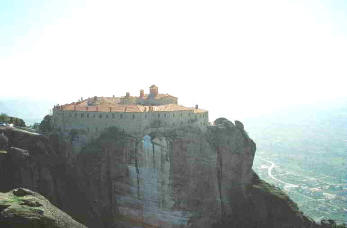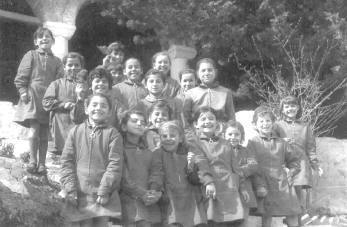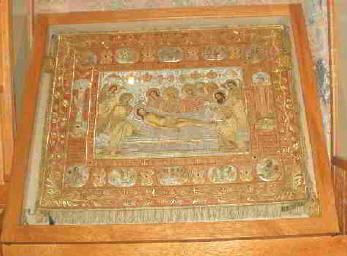|
The
monastery is built on top of a rock which rests on an area of
7,500 square meters. It is over Kalambaka, at the southeast
edge of the Meteora rocks.
The first hermit to be hosted by the rock, as evidenced by an
inscription near the entrance of the monastery in the year
1192 AD., was Jeremiah. This piece of information is also
verified by historical researchers.

However, the first possessor of the Monastery was the
Archimandrite Anthony around the 16th century. Tradition seems
to have associated him with the historical Byzantine family of
the Cantacuzene.
The second possessor of the monastery was the monk Philotheus
coming from the village Sthlataina or Sklataina (its current
name is Rizoma, municipality Paralithaion) in the mid 16th
century.
In 1545,
Saint Philotheus restored or reconstructed the small church of
St. Stephen.
The
church is a basilica with a wooden esonarthex separated from
the nave with a trivilo opening.
The
church was painted in 1545 under Abbot Metrophanes.
The Saint Philotheus built
cells for the monks, supplied the monastery with church
utensils and manuscripts and imposed the coenobitic lifestyle
in the convent. In the Narthex, on the left and right
side of the entrance, the Saint possessors of the monasteries,
monks Anthony and Philotheus, are depicted divinely,
accompanied by the archangels Gabriel and Michael. There is
also a display of the 24 hymns to Mary.
Above the entrance there is an
inscription that informs visitors about the murals of the
church without providing any dates whatsoever.
In the sanctuary, there is the Lady of the Signs in a niche,
as a guardian of Christians and the whole world, the Holy
Communion and images of great Hierarchs.
The
paintings are well cleaned and preserved today.
The second church is dedicated to the Holy Martyr Haralambos
and was erected in 1798 under Abbot Ambrose.
The
church follows the Mount Athos’ architectural type. The main
church is four-cruciform, with a roomy esonarthex set before
two alcoves on the left and right side, with 4 columns in the
center that support the roof. The three slender and lanky
domes are quite characteristic. Abbot Constantine from
Kalambaka erected the Holy Table of the church in 1857 and
other buildings near the Church of St. Stephen. The
monastery offered a great lot to education during those
troubled times. It constructed
the Constantios school in Kalambaka and donated huge sums of
money to build schools in Trikala.In
the 1970s, there was an Elementary school and an orphanage for
girls in the monastery, taught by its nuns.
Abbot Constantine from
Kalambaka erected the Holy Table of the church in 1857 and
other buildings near the Church of St. Stephen. The
monastery offered a great lot to education during those
troubled times. It constructed
the Constantios school in Kalambaka and donated huge sums of
money to build schools in Trikala.In
the 1970s, there was an Elementary school and an orphanage for
girls in the monastery, taught by its nuns.
The
iconostasis is carved and sculpted by artisans from Metsovo in
1814. It comprises themes taken from the vegetable and animal
kingdom; syntheses refer to the Last Supper, Saint Dimitrios,
Saint Stephen the protomartyr and St. George. The iconostasis’
value is inestimable.
On the outer side of the exonarthex there are three
inscriptions.
The
first one, on the right, alludes to the construction of the
monastery by Paisios, Bishop of Stagoi.
The second one refers to a
prayer of the Bishop of Stagoi. Finally, the third
cites the foundation of the iconostasis, and also mentions the
pioneers who undertook the project in case.
The
double-headed eagle, carved in a circle, an eternal symbol of
the Byzantine Empire is depicted in the centre of the
iconostasis.
The Holy
relics of Saint Haralambos are stored in the monastery since
1398, when it was donated to the Ruler of Wallachia
Vlatislavos.
 In
the past few years the monastery’s icons are being illustrated
by the painter Vlassios Tsotsonis, following the standards of
other Katholika and traditions in Meteora. In
the past few years the monastery’s icons are being illustrated
by the painter Vlassios Tsotsonis, following the standards of
other Katholika and traditions in Meteora.
In 1888,
there were 31 monks in the monastery and in 1960 it got
deserted.
Since
1961 the monastery has been converted into a nunnery and is
currently prospering. The nuns, under particularly
adverse circumstances, managed to organize and ameliorate the
building conditions of the monastery. The Coenobitic lifestyle
and the so far configured Orthodox rite are systematically
adopted.
The
monastery’s offer to education and the nation’s constant
struggles should also be noted.
Since
1971 an Elementary school – girls’ Boarding School – with 18
students began operating. The monastery’s offer under the care
of the teachers - nunsTheognosti Ampelakioti, Theostrati as
well as other nuns of the monastery need to be taken into
serious consideration. The students were mainly orphan girls,
along with destitute children and children coming from
families with several members. There, they found the love, the
affection and everything else that they had been deprived of
due to the aggravating conditions they met with in their
lifetimes. It ran until 1977 and approximately 40 students
attended it. The nuns presumed that it was important to offer,
apart from their spiritual duties, their services to the
society.
This is the reason why they
offered food, shelter, education, care, affection and love to
the orphans of the prefecture of Trikala. We are thus well -
reminded of the "The Secret School", in the difficult
years our nation had to go through, that kept our nation, our
history and our religion alive.
Access to the monastery is achieved easier than access to
other monasteries, thanks to an 8 metres’ bridge connecting
the monastery’s rock with the hill Koukoula.
In 1991, the monastery was renovated and the new vestry was
re-organized so that this monumental wealth could be
preserved and highlighted. The design and construction of the
new vestry were conducted under the supervision of the
architect Sotirios Tzimas.
There is
a priceless treasure in the new vestry. The sacred icons
gathered by the churches are currently kept in the monastery’s
sacristy; their grace is miraculous and they have witnessed
the endless struggles towards their protection and
restoration.

The most important and oldest incunabula are the works of
Aristotle, printed in 1498.
There he
kept the Swedish dictionary, the dictionary of Varinia
Favorinou since the 14th century.
The
record of the incunabula was kept by the nuns. There is a
total number of 852 incunabula preserved and divided
into categories and sub- categories: theological, literary,
literary - historical, philosophical and legal.
In the
sacristy there are priestly vestments, epitrachilia,
epigonatia and a brocade Epitaph since the year 1857.
There are also liturgical utensils, Holy Glasses, Holy
Tabernacles and Holy Spears, forceps, ancillary equipment for
the Holy Liturgy, belts
and priestly buckles as well as some folk art.
Manuscripts, Bibles, Crosses, Episcopal thrones dating back to
the 17th century, Lecterns and coffers of the 17th century are
also stored there.
Additionally, there are still 154 manuscripts, four of which
are parchments from the 11th to the 19th
century.
Due to personal devotion and love the nuns took care of the
monastery and attended to its preservation and restoration
needs of the existent objects and artifacts. Hearty zeal and
diligence were displayed at the refinement of the Byzantine
tradition and music that is heard throughout the celebrations
of the Saints. Workshops running: icons’, calligraphy,
decorative, manuscipts’, gold embroidery, sewing,
manufacturing incense, candles, and various types of
needlework.
Opening Hours of the St. Stephen's Monastery
|
SUMMER |
WINTER |
|
9.00
am to 1.30 am |
9.00
am to 1.00 pm |
|
3.30
am to 5.30 pm |
3.00
pm to 5.00 pm |
|
Closed on Mondays |
Closed on Mondays |
|
Telephone
Number:
24320-22279 |
Translation by Christine Boutsia

Visit of Ecumenical Patriarch Dimitrios in
Meteora Monastery of Saint Stephen
VIDEO
|